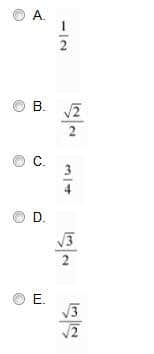GRE GRE-TEST Exam Dumps
Vendor: GRE
Exam Code: GRE-TEST
Exam Name: Graduate Record Examination Test: Verbal, Quantitative, Analytical Writing
Certification: GRE Certifications
Total Questions: 403 Q&A ( View Details)
Updated on: Mar 24, 2025
Note: Product instant download. Please sign in and click My account to download your product.
- 99.5% pass rate
- 12 Years experience
- 7000+ IT Exam Q&As
- 70000+ satisfied customers
- 365 days Free Update
- 3 days of preparation before your test
- 100% Safe shopping experience
- 24/7 Support
GRE GRE-TEST Last Month Results
Free GRE-TEST Exam Questions in PDF Format
- File
- Size
- GRE_leads4pass_GRE-TEST_by_Jay_354.pdf
- 211.59 KB
- GRE_leads4pass_GRE-TEST_by_farouq_327.pdf
- 239.56 KB
- GRE_leads4pass_GRE-TEST_by_singh-shivam_356.pdf
- 213.05 KB
- GRE_leads4pass_GRE-TEST_by_Valdiz_388.pdf
- 231.37 KB
- GRE_leads4pass_GRE-TEST_by_asq_366.pdf
- 237.16 KB
- GRE_leads4pass_GRE-TEST_by_Luis_354.pdf
- 215.22 KB
GRE-TEST Online Practice Questions and Answers
Whatever the level of the museum's past (i)_________American art. it pales beside its current (ii)_________. Since
opening its renovated and expanded building, the museum has relegated American paintings to hard-to-find comers of
the museum. It is as if American art is < iii >_________the overwhelmingly European narrative that dominates the permanent collection galleries.
A. advocacy of
B. enthusiasm for
C. neglect of
D. craze
E. disdain
F. support
G. fundamental to
H. excluded from
I. privileged over
Exhibit.

A. Quantity A is greater.
B. Quantity B is greater.
C. The two quantities are equal.
D. The relationship cannot be determined from the information given.
A circle is inscribed in a regular hexagon that is inscribed in a circle. What is the ratio of the area of the smaller circle to the area of the larger circle?

A. Option A
B. Option B
C. Option C
D. Option D
E. Option E
Hot Exams
Related GRE Certifications
Why GRE-TEST Dumps Are Worth It
Hannah Johnson
Leads4Pass is one of the best websites I have ever used. It only took me 3 days of preparation to complete my goal plan. Not only that, I was successful with high scores.
Joel C
It was the 16th when I purchased the Leads4Pass materials. They updated the materials on the 18th. When I asked them to send me the latest materials, they quickly sent me the latest ones. The new materials included several of the latest core question types. Finally, I succeeded. Six of the new core questions were completely matched. Thank you!
Martha W
I have used free materials, the privacy is poor, the public content matching rate is too low,I gave up on them because they failed me once. Leads4Pass was recommended by a friend. Both the privacy protection and the preciousness of the materials are very high. By the way, I won this time.
David Frazier
There is nothing more satisfying than success! Their question types are very similar, and they were very helpful to my progress in answering questions during the exam. Thank you.
Dolores N
I need to take multiple certification exams for my organization. There are so many certification exams that I can't help but choose supporting materials. I have tried multiple platforms with some success and failure. In the end, I chose Leads4Pass. It was instant for me. Effective materials are where the real value lies.
Helen Kovac
I was despised by a close friend until he failed twice and I passed once and then he changed his mind. He shared his failure experience with me. He told me that he had been learning through books and looking for free materials. These outdated contents could not really help him. Later I recommended him Leads4Passs and he also succeeded.
Raymond I
I was lucky enough to choose Leads4Pass for the first time. I used their VCE tool to learn, and it was really easy and efficient. I think what’s really amazing is that they can ensure that all materials are industry-leading, which is really amazing.
Leads4Pass GRE Certifications GRE-TEST Exam Analysis
The following table comprehensively analyzes the quality and value of GRE Certifications GRE-TEST exam materials.

100% safe shopping
100% real and effective
100% money back guarantee
Leads4Pass guarantee comes from more than 10 years of experience and reputation

 Printable PDF
Printable PDF